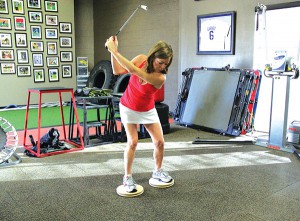
Proper alignment and structure can help alleviate injury.
For the most part, golf is an athletic event. Hitting that little ball off the tee, keeping it in the fairway and dropping it into that little hole is a lot of work. However, golf isn’t always viewed this way. It’s often considered a day in the park hanging with friends and enjoying the beautiful outdoors.
Let’s consider the movement required. The average golfer’s driver club head speed is approximately 85-90 mph while a touring pro can average 112-120 mph. Ball speed respectively is 125-165 mph. On the down swing, the body can be in three different planes of motion all at once. These are merely a few of the factors that contribute to the reality of the game: golf is a sport, and as with all sports, it can be tough on the body, producing many injuries with the back, shoulder, elbow and wrist at the top of the list.
A lot is invested in this game with ever-changing technology in clubs, ball design, shoe and outerwear, but the bottom line is that the golfer is the most important part of the game and if he or she is broken, the outing will be miserable. And we all know golfers often have the obsession of wanting to play every day no matter what is going on with the weather, playing conditions, or their body.
Thus, preparing your body to play the game is an important factor that many overlook. A good place to start is a functional movement screen (FMS) which can help identify a physical problem before it occurs. FMS is a physical screen conducted by a certified trainer or therapist. The philosophy was first introduced in 1995 by Gray Cook, MPT, and Lee Burton as a means of identifying asymmetries in functional movement patterns that could potentially lead to injury. For those with existing pain, there is a more advanced system called SFMA (selected functional movement assessment).
The FMS has 7 screens: 1) The overhead squat; 2) hurdle step; 3) inline lunge; 4) shoulder mobility movement pattern; 5) straight leg raise; 6) trunk stability push-up test; 7) rotary stability test, and two clearing tests. Each test is graded separately from 0-3. If the client receives a 0 there was pain with the movement; a 1 means they were unable to perform the test with the criteria given; 2 indicates that the client was able to complete the test but it was modified; and 3 means they passed the test with perfect form. Once the scores are tallied, a corrective exercise program is developed to correct the worst scored functional pattern followed by the next area that needs improvement and so on.
Restoring movement before painful patterns are identified can help keep you on course for many healthy years ahead. The best news? The screen not only improves your health and form, but can also improve your game.
Michael K Butler is co owner of Kinetix Health and Performance Center in Palm Desert and is certified with distinction honors as a strength coach through the NSCA. He is also a full body Active Release Therapist and a level 2 TPI medical trainer. (760) 200.1719. KinetixCenter.com.














































Comments (0)